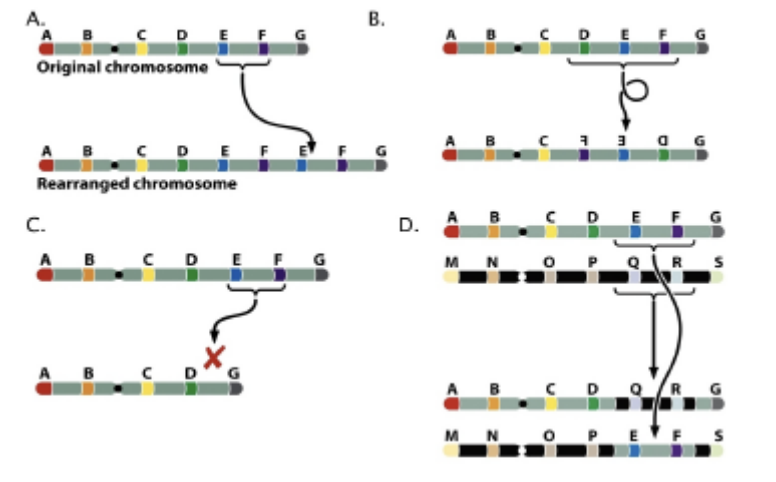genetics exam 2 review
1/10
There's no tags or description
Looks like no tags are added yet.
Name | Mastery | Learn | Test | Matching | Spaced |
|---|
No study sessions yet.
11 Terms

Which of the following chromosome rearrangements represents inversion?
B
How did Alfred Hershey and Martha Chase contribute to our understanding of DNA?
a. They determined that DNA contains four different nitrogenous bases.
b. They used X-ray diffraction to examine the structure of DNA.
c. They discovered the "transforming principle" that could genetically alter bacteria.
d. They found that the phosphorus-containing components are the genetic material of phages.
d. They found that the phosphorus-containing components are the genetic material of phages.
What enzyme is used to break down proteins?
a. ribonuclease
b. trypsin
c. polymerase
d. RNase
b. trypsin
Two parents are phenotypically normal, but one of their four biological children has a typical autosomal recessive trait. The other three children are phenotypically normal. It is very likely that:
a. the parents are both heterozygous for the trait.
b. the affected child is a girl.
c. if the affected child eventually marries a phenotypically normal spouse, all of their children will have the trait.
d. the affected child is a boy.
a. the parents are both heterozygous for the trait.
Heat can disrupt hydrogen bonding between DNA strands. Which of the following DNA strands would denature at the LOWEST temperature?
a. 10% AT and 90% GC
b. 50% AT and 50% GC
c. 70% AT and 30% GC
d. 90% AT and 10% GC
d. 90% AT and 10% GC
Why was the idea that genes are made of nucleic acids NOT widely accepted until after 1950?
a. DNA was not chemically stable for long enough to be a good method of storing genetic information.
b. Proteins are more abundant than nucleic acids, so it seemed more logical that proteins would carry genetic information.
c. Nothing was known about the chemistry of DNA until after 1950.
d. Until the structure of DNA was understood, how DNA could store and transmit genetic information was unclear.
d. Until the structure of DNA was understood, how DNA could store and transmit genetic information was unclear.

The following table shows Chargaff's data that demonstrate base composition of DNA from different biological sources. Which of the following is NOT a general conclusion that is supported by these data?
a. DNA consists of a series of four-nucleotide units, each containing all four bases—ATGC—in a fixed sequence.
b. The amount of adenine is always equal to the amount of thymine.
c. (A + G) / (T + C) = 1
d. Although the ratio of A/T and G/C is the constant, the relative amount of any particular base varies between species.
a. DNA consists of a series of four-nucleotide units, each containing all four bases—ATGC—in a fixed sequence.
What type of organism results from the hybridization of a haploid gamete from one species with a diploid gamete from a different species?
a. allotriploid
b. allotetraploid
c. allodiploid
d. autotetraploid
a. allotriploid
DNA molecules have a _____ charge at physiological pH because of their _____.
a. negative; phosphate groups
b. negative; hydroxyl groups
c. positive; nitrogenous bases
d. positive; sugar groups
a. negative; phosphate groups
Most pedigrees showing the hypothetical human trait show the following characteristics:
- Females are affected twice as frequently as males.
- Affected fathers may have affected daughters but never affected sons.
- Half the children of affected mothers and normal fathers are affected.
What is the MOST likely mode of inheritance for this disorder?
a. autosomal recessive
b. X-linked dominant
c. Y-linked
d. autosomal dominant
b. X-linked dominant